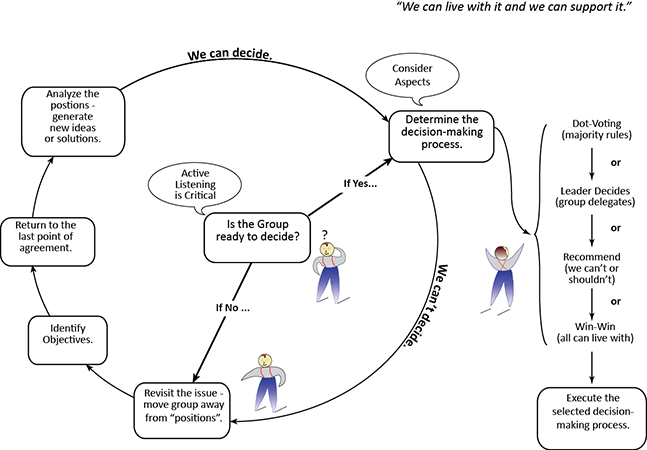January 2014 - The FoCuSeD™ Facilitator eNewsletter

Changing How Decisions are Made | Gary Rush Facilitation
I’ve been thinking about collaboration since it is rather core to what I do in Facilitation. “Collaboration” may be an overused buzzword, but I believe authentic collaboration (see my December 2013 FoCuSeD™ eNewsletter, "Achieving Authentic Collaboration") is required for us to make the “right” decisions and we need to change how those decisions are made.
It’s interesting how everyone seems to understand the need for “collaboration”, but whenever I come across someone in a leadership role, they push back that the final decision still belongs to the leader. Everyone gets that engaging others is important, but it seems more for advice and participation. First of all, understand that I fully believe that decisions made by consensus following a well-managed process leads to better outcomes, are time saving, effective, supported by all, and can be innovative. Decision methods that use default, delegation, recommendation, or voting (including dot-voting) are not collaborative – they are command and control – by one or by a majority.
How do we move from a command and control style of decision-making to a consensus-based collaborative decision-making style?
Let’s assume that you are in a leadership role. How do you get a group of people working with you or for you to make consensus-based decisions – authentic collaboration? I believe that the role of the leader is not to make the decision. It is to guide the group to make the “right” decision by ensuring that they have the needed information and then guiding (facilitating) them through a process (context) that ensures everyone has an equal opportunity to participate and be heard, that the dialog allows healthy conflict, and then moving the group to a consensus-based decision – one that is high quality and supported by all. So, how do you do that? This is fairly straightforward: identify and gather the needed information, elicit ideas (diverge), understand the ideas (struggle), and move to consensus (converge).
The Process – Identify and Gather Needed Information
Ask the group to identify what information is needed to effectively make a well-informed decision. The information needs to be complete, accurate, and from varied sources to bring differing perspectives. Avoid, “We already know what we need to know.” It is easy to miss critical information. Avoid, “We already know the answer.” Never assume. Avoid “We got it.” Challenge them.
Once the needed information is identified, ask the group to identify those who will gather the information and set a deadline. With the information gathered, ensure that everyone has an equal opportunity to review, absorb, and understand the information.
The Process – Elicit Ideas (Diverge)
Divergence is the first step to making well-informed decisions. Divergence gives groups differing perspectives and ideas. It is important that everyone has an equal opportunity to contribute. Everyone in the group must contribute to reach consensus. Note: If one or a few dominate others, ask everyone to contribute anonymously using Post-its or some other media. If the group is large, you can break it into smaller groups of 3 to 5 people each. It is often easier for someone to contribute in smaller groups. Set the example that all ideas are respected. Don’t allow judging statements – discussion of the ideas comes later.
The Process – Understand the Ideas (Struggle)
Because people think differently, they will struggle with the newfound information to understand each other’s perspective or point of view. Healthy conflict is essential. Note: Discuss ideas, not people. Many arguments come from lack of understanding someone else's perspective. Avoid groupthink by getting the group to fully discuss the ideas and does not just go with an easy fix. If no one questions information or ideas, no one is thinking.
The Process – Move to Consensus (Converge)
Through discussion of ideas, understanding is gained. Listen to the group and feedback what they are saying – they often don’t hear each other. Keep them away from getting stuck on only one “right” answer. Summarize what seems to be a trend, a movement, or a feeling that tends to converge on a decision. Note: It is important that the group understands that consensus means, “I can live with it and I can support it.” Make sure that if someone compromises, it is positive – “I can back off this far for the benefit of…” rather than – “I give up, I’ll go half way.” Compromising one’s position is sometimes needed to find a win-win solution – consensus – whereas compromising by giving up leads to poor decisions.
Conclusion
Making well-informed decisions in a consensus-based collaboratively style, requires you to enable and empower the group. You enable by providing a clear process – diverge, struggle, converge. You empower by enabling healthy conflict.
I have found that consensus-based collaborative decision-making leads to better outcomes that are supported by all people – win-win. ![]()

